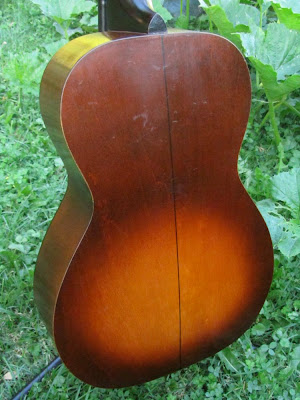c.1935 Slingerland May-Bell "Parlor" Guitar #2
This is #2 of a pair of this same model I just worked on, and like #1 was made by Regal for Slingerland who used their "May-Bell" brand on it.
It's crack-free, with good finish, and has a clear, midrange, sweet voice. Like #1, it's also "transverse braced" which is a modification of ladder bracing that puts the main braces at more of an angle, lending a bit more stiffness and more of an x-braced tonality. As a rule, it's lightweight bracing, though, and requires lighter gauges (I have DR Sunbeam 48w-10s on this, though 50w-11 would also be OK).
My work included a neck reset, bridge shave/new saddle, new bridge pins, tuner lube, fret level/dress, cleaning, and setup. Installing fret saddles (which were original to both #1 and #2 of these guitars) after doing a bridge shave can sometimes be worrying because it's hard to calculate the true deflection of the top before strings are up to tension. Fortunately, for both of these, there was only minor deflection so the setup remained nice and fast and the saddle didn't need to be lowered.
The decal is nice and strong on this one. Original wood nut.
Smooth, dyed-maple fretboard with white celluloid dots. The frets are original brass. There's a small amount of chip-out at the 12th fret on the board, but it's not substantial.
Medium "redburst" finish is in great shape.
Like #1, this has a stenciled "rosette," faux-binding (painted) on the top edge, and real (celluloid) binding around the soundhole.
I had to shave the bridge area so the top profile is re-dyed black with a thin coat of finish over it. This bridge is hard maple rather than a tropical hardwood, which is why Regal dyed these black.
The "backstrip" is painted.
Tuners work great!
Good neck set, now.
Hmm, guitars growing with the pumpkins!
No endpin on the "endstrip." This is usually the case when guitars were primarily sold as Hawaiian/lap slide instruments, as many flattop guitars tended to be during the 20s and 30s. This was probably sold with a metal "raised nut" that slipped on over the wooden nut to aid in raising the strings for lap play.














Comments